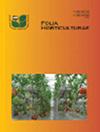Studies of the pollen characteristics and the taxonomic significance of Impatiens from the Yunnan–Guizhou Plateau
IF 1.8
4区 农林科学
Q2 HORTICULTURE
引用次数: 0
Abstract
ABSTRACT Impatiens is rich in germplasm resources, with more than 260 species in China. A study on the pollen micromorphology of Impatiens by scanning electron microscopy (SEM) showed that the pollen characteristics were richly diverse, and there was some correlation among the characteristics. In addition, the micromorphological index can be used for an effective cluster analysis of Impatiens. However, there was high interspecific similarity in some Impatiens, and the classification of Impatiens cannot be accurate to the species using pollen characteristics. Based on the classification conditions of Impatiens, the characteristics of the pollen structure were found to be useful to classify Impatiens into subgenera or smaller groups. The macroscopic characteristics and the number of sepals (NS) were used as references, which enabled the conclusion that there were 11 indices in the pollen micromorphological index, and the taxonomic effect was greater than the NS. In summary, the pollen micromorphology of Impatiens plays an important role in the classification of Impatiens. The purpose of this study was to explore this characteristic of Impatiens, which has some reference significance to supplement the pollen characteristics and palynological classification of Impatiens. The goal for this research was to aid in the interspecific identification and genetic breeding of Impatiens.云贵高原凤仙花花粉特征及其分类意义的研究
摘要凤仙花种质资源丰富,在我国有260多种。用扫描电镜对凤仙花花粉的微观形态进行了研究,结果表明,凤仙花的花粉特征丰富多样,各特征之间存在一定的相关性。此外,微形态指标可用于凤仙花的有效聚类分析。然而,一些凤仙花的种间相似性很高,利用花粉特征对凤仙花进行分类并不准确。根据凤仙花的分类条件,发现花粉结构特征有助于将凤仙花分为亚属或更小的类群。以花粉的宏观特征和萼片数(NS)为参考,得出花粉微形态指数中有11个指标,分类效果大于NS的结论。总之,凤仙花的花粉微形态在凤仙花分类中起着重要作用。本研究旨在探讨凤仙花的这一特征,对补充凤仙花花粉特征和花粉分类具有一定的参考意义。本研究的目的是帮助凤仙花的种间鉴定和遗传育种。
本文章由计算机程序翻译,如有差异,请以英文原文为准。
求助全文
约1分钟内获得全文
求助全文
来源期刊

Folia Horticulturae
Agricultural and Biological Sciences-Horticulture
CiteScore
3.40
自引率
0.00%
发文量
13
审稿时长
16 weeks
期刊介绍:
Folia Horticulturae is an international, scientific journal published in English. It covers a broad research spectrum of aspects related to horticultural science that are of interest to a wide scientific community and have an impact on progress in both basic and applied research carried out with the use of horticultural crops and their products. The journal’s aim is to disseminate recent findings and serve as a forum for presenting views as well as for discussing important problems and prospects of modern horticulture, particularly in relation to sustainable production of high yield and quality of horticultural products, including their impact on human health.
 求助内容:
求助内容: 应助结果提醒方式:
应助结果提醒方式:


